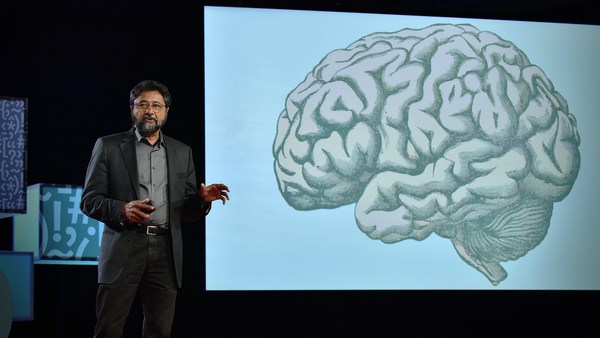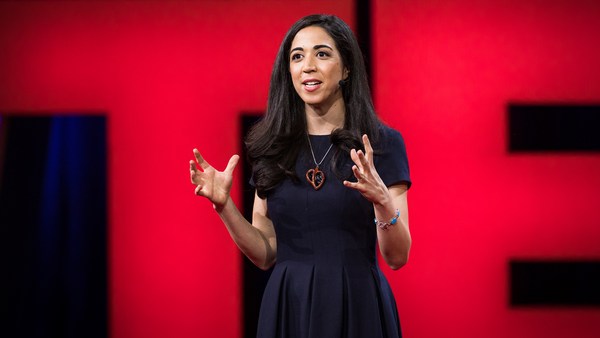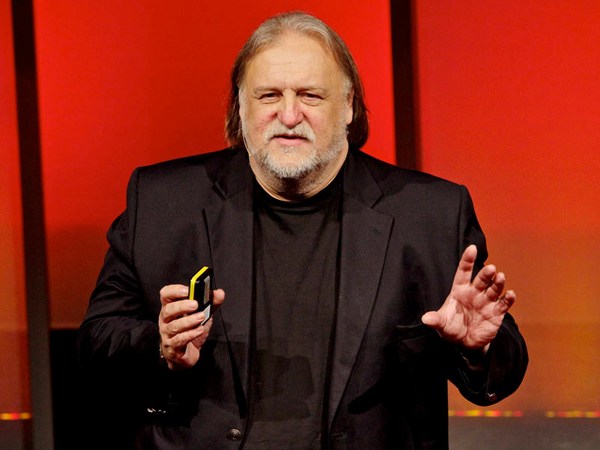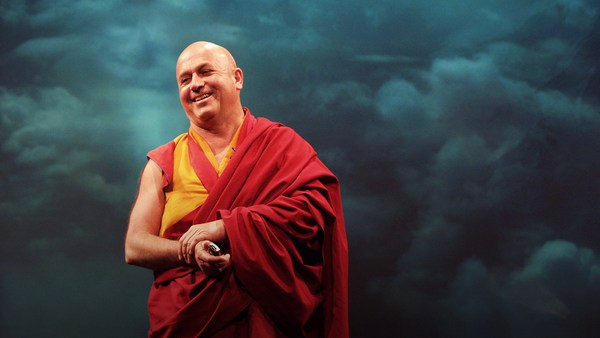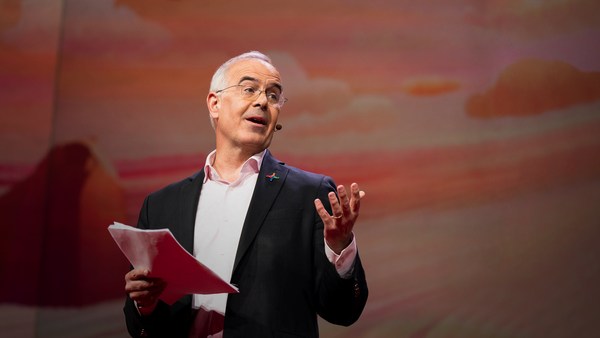It's 2008, and I'm just finishing my first year of design school. And I'm at my first year-end review, which is a form of ritual torture for design students, where they make you take everything you made over the course of the year and lay it out on a table and stand next to it while a bunch of professors, most of whom you've never seen before, give you their unfiltered opinions of it. So it's my turn and I'm standing next to my table, everything neatly lined up, and I'm just hoping that my professors can see how much effort I've put into making my designs practical and ergonomic and sustainable. And I'm starting to get really nervous, because for a long time, no one says anything. It's just completely silent. And then one of the professors starts to speak, and he says, "Your work gives me a feeling of joy."
Joy? I wanted to be a designer because I wanted to solve real problems. Joy is nice, I guess, but it's kind of light -- not substantial. But I was also kind of intrigued, because joy is this intangible feeling, and how does that come from the stuff on the table next to me? I asked the professors, "How do things make us feel joy? How do tangible things make us feel intangible joy?" They hemmed and hawed and gestured a lot with their hands. "They just do," they said.
I packed up my things for the summer, but I couldn't stop thinking about this question ... and this launched a journey -- one that I didn't know at the time would take me 10 years -- to understand the relationship between the physical world and the mysterious, quixotic emotion we call "joy." And what I discovered is that not only are they linked, but that the physical world can be a powerful resource to us in creating happier, healthier lives.
After my review, I thought, "I know what joy feels like, but what is it, exactly?" And I found that even scientists don't always agree, and they sometimes use the words "joy" and "happiness" and "positivity" more or less interchangeably. But broadly speaking, when psychologists use the word joy, what they mean is an intense, momentary experience of positive emotion -- one that makes us smile and laugh and feel like we want to jump up and down. And this is actually a technical thing. That feeling of wanting to jump up and down is one of the ways that scientists measure joy. It's different than happiness, which measures how good we feel over time. Joy is about feeling good in the moment, right now. And this was interesting to me because as a culture, we are obsessed with the pursuit of happiness, and yet in the process, we kind of overlook joy.
So this got me thinking: Where does joy come from? I started asking everyone I knew, and even people I just met on the street, about the things that brought them joy. On the subway, in a café, on an airplane, it was, "Hi, nice to meet you. What brings you joy?" I felt like a detective. I was like, "When did you last see it? Who were you with? What color was it? Did anyone else see it?" I was the Nancy Drew of joy.
(Laughter)
And after a few months of this, I noticed that there were certain things that started to come up again and again and again. They were things like cherry blossoms and bubbles ... swimming pools and tree houses ... hot air balloons and googly eyes --
(Laughter)
and ice cream cones, especially the ones with the sprinkles. These things seemed to cut across lines of age and gender and ethnicity. I mean, if you think about it, we all stop and turn our heads to the sky when the multicolored arc of a rainbow streaks across it. And fireworks -- we don't even need to know what they're for, and we feel like we're celebrating, too. These things aren't joyful for just a few people; they're joyful for nearly everyone. They're universally joyful. And seeing them all together, it gave me this indescribably hopeful feeling. The sharply divided, politically polarized world we live in sometimes has the effect of making our differences feel so vast as to be insurmountable. And yet underneath it all, there's a part of each of us that finds joy in the same things. And though we're often told that these are just passing pleasures, in fact, they're really important, because they remind us of the shared humanity we find in our common experience of the physical world.
But I still needed to know: What is it about these things that makes them so joyful? I had pictures of them up on my studio wall, and every day, I would come in and try to make sense of it. And then one day, something just clicked. I saw all these patterns: round things ... pops of bright color ... symmetrical shapes ... a sense of abundance and multiplicity ... a feeling of lightness or elevation. When I saw it this way, I realized that though the feeling of joy is mysterious and elusive, we can access it through tangible, physical attributes, or what designers call aesthetics, a word that comes from the same root as the Greek word "aísthomai," which means, "I feel," "I sense," "I perceive." And since these patterns were telling me that joy begins with the senses, I began calling them "Aesthetics of Joy"; the sensations of joy. And in the wake of this discovery, I noticed something that as I walked around, I began spotting little moments of joy everywhere I went -- a vintage yellow car or a clever piece of street art. It was like I had a pair of rose-colored glasses, and now that I knew what to look for, I was seeing it everywhere. It was like these little moments of joy were hidden in plain sight.
And at the same time, I had another realization, that if these are the things that bring us joy, then why does so much of the world look like this?
(Laughter)
Why do we go to work here? Why do we send our kids to schools that look like this? Why do our cities look like this? And this is most acute for the places that house the people that are most vulnerable among us: nursing homes, hospitals, homeless shelters, housing projects. How did we end up in a world that looks like this?
We all start out joyful, but as we get older, being colorful or exuberant opens us up to judgment. Adults who exhibit genuine joy are often dismissed as childish or too feminine or unserious or self-indulgent, and so we hold ourselves back from joy, and we end up in a world that looks like this.
But if the aesthetics of joy can be used to help us find more joy in the world around us, then couldn't they also be used to create more joy? I spent that last two years scouring the planet, looking for different ways that people have answered this question. And this led me to the work of the artist Arakawa and the poet Madeline Gins, who believed that these kinds of environments are literally killing us. And so they set out the create an apartment building that they believed would reverse aging. And this is it.
(Laughter)
(Applause)
It's a real place, just outside Tokyo. I spent a night there, and it's a lot.
(Laughter)
The floors undulate, so you don't end up walking around so much as kind of bouncing around the apartment, and there are bright colors in every direction. I'm not sure I left any younger, but it's as if, by trying to create an apartment that would make us feel youthful, they ended up creating one that was joyful. And yes, this is a bit much for everyday life, but it made me wonder: What about the rest of us? How do we bring these ideas back into the real world?
So I started finding people who were doing just that. For example, this hospital, designed by the Danish artist Poul Gernes. Or these schools, transformed by the non-profit Publicolor. What's interesting is that Publicolor has heard from school administrators who say that attendance improves, graffiti disappears and kids actually say they feel safer in these painted schools. And this aligns with research conducted in four countries, which shows that people working in more colorful offices are actually more alert, more confident and friendlier than those working in drab spaces.
Why would this be the case? Well, as I started to trace back our love of color, I found that some researchers see a connection to our evolution. Color, in a very primal way, is a sign of life, a sign of energy. And the same is true of abundance. We evolved in a world where scarcity is dangerous, and abundance meant survival. So, one confetto -- which happens to be the singular of confetti, in case you were wondering --
(Laughter)
isn't very joyful, but multiply it, and you have a handful of one of the most joyful substances on the planet. The architect Emmanuelle Moureaux uses this idea in her work a lot. This is a nursing home she designed, where she uses these multicolored spheres to create a feeling of abundance. And what about all those round things I noticed? Well, it turns out neuroscientists have studied this, too. They put people into fMRI machines, and they showed them pictures of angular objects and round ones. And what they found is that the amygdala, a part of the brain associated in part with fear and anxiety, lit up when people looked at angular objects, but not when they looked at the round ones. They speculate that because angles in nature are often associated with objects that might be dangerous to us, that we evolved an unconscious sense of caution around these shapes, whereas curves set us at ease.
You can see this in action in the new Sandy Hook Elementary School. After the mass shooting there in 2012, the architects Svigals + Partners knew that they needed to create a building that was secure, but they wanted to create one that was joyful, and so they filled it with curves. There are waves running along the side of the building, and these squiggly canopies over the entryway, and the whole building bends toward the entrance in a welcoming gesture.
Each moment of joy is small, but over time, they add up to more than the sum of their parts. And so maybe instead of chasing after happiness, what we should be doing is embracing joy and finding ways to put ourselves in the path of it more often. Deep within us, we all have this impulse to seek out joy in our surroundings. And we have it for a reason. Joy isn't some superfluous extra. It's directly connected to our fundamental instinct for survival. On the most basic level, the drive toward joy is the drive toward life.
Thank you.
(Applause)
Thank you.
Thank you, thank you.
(Applause)
